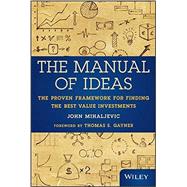Considered an indispensable source of cutting-edge research and ideas among the world's top investment firms and money managers, the journal The Manual of Ideas boasts a subscribers list that reads like a Who's Who of high finance. Written by that publication’s managing editor and inspired by its mission to serve as an "idea funnel" for the world's top money managers, this book introduces you to a proven, proprietary framework for finding, researching, analyzing, and implementing the best value investing opportunities. The next best thing to taking a peek under the hoods of some of the most prodigious brains in the business, it gives you uniquely direct access to the thought processes and investment strategies of such super value investors as Warren Buffett, Seth Klarman, Glenn Greenberg, Guy Spier and Joel Greenblatt.
- Written by the team behind one of the most read and talked-about sources of research and value investing ideas
- Reviews more than twenty pre-qualified investment ideas and provides an original ranking methodology to help you zero-in on the three to five most compelling investments
- Delivers a finely-tuned, proprietary investment framework, previously available only to an elite group of TMI subscribers
- Step-by-step, it walks you through a proven, rigorous approach to finding, researching, analyzing, and implementing worthy ideas








